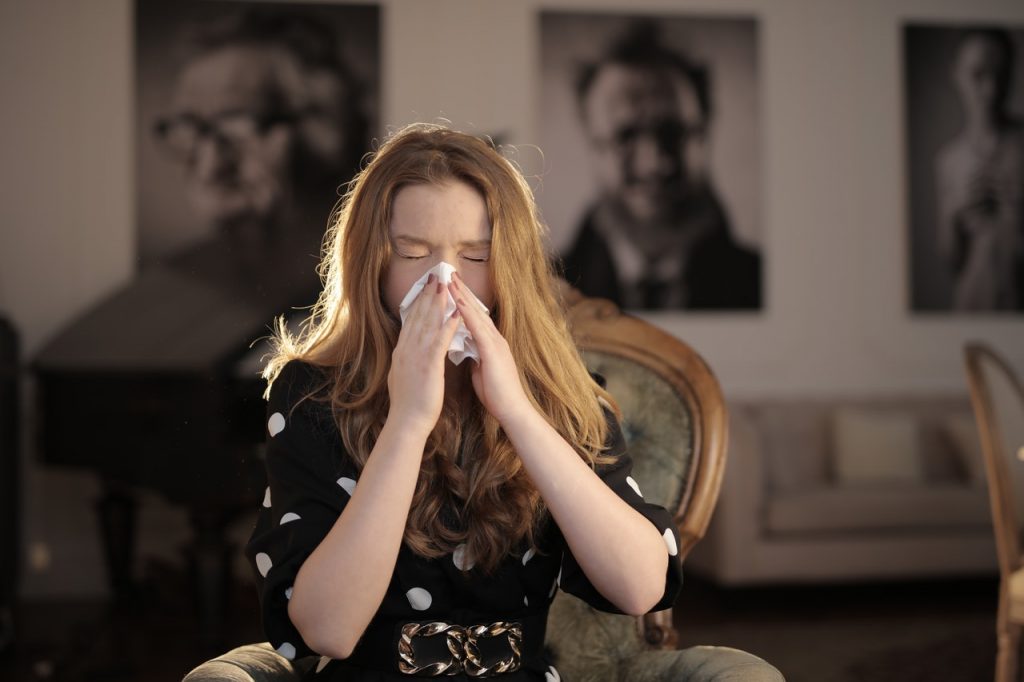
The common cold is a mild viral infection. Although it lasts only a few days, its symptoms can be troublesome. When should you be patient and wait for it to pass on its own, and when should you consult a doctor? Read!
The viruses that cause the common cold are responsible for sneezing, runny nose, sinus pain, and a “blocked nose” feeling. Cold symptoms appear gradually and last from 5 to 7 days, sometimes longer. The frequency of colds is related to age. A two-year-old child may catch a cold up to 10 times in a year, while an elderly person may not catch one at all. This has to do with the fact that with age the immune system learns how to fight all the viruses around us.
Usually the first symptom of a cold is a sore throat, which after some time is joined by sneezing, runny nose and sinus pain, i.e. inflammation of the nasal mucous membrane. It may also be accompanied by other symptoms, such as a slightly elevated temperature, a feeling of discomfort, watery eyes and a cough. These symptoms go away within a few days.
Sometimes, a few days after the onset of a cold, more serious symptoms appear. They are usually a sign of bacterial overgrowth and require a visit to the doctor. Don’t ignore temperatures above 39℃, thick and yellow nasal discharge, conjunctivitis, and pain suggestive of sinusitis, ear infections, and tonsillitis.

Symptoms of a cold are similar to those of the flu, with the difference that in the case of the latter the symptoms are much more intense. The flu is accompanied by a feeling of disorientation, muscle aches and headaches, as well as high fever.
In addition to similar symptoms, the flu and the common cold have many things in common. Both infections are associated with cold and temperature changes, are highly contagious, and are caused by a virus. The influenza virus, which comes in three varieties (A, B and C), penetrates the blood and spreads throughout the body, causing general malaise. In contrast, the common cold is usually caused by rhinoviruses, attacking the nose and throat.
A common misconception is that a fever accompanies the flu, but a cold can also cause a fever. It also happens that a person with flu does not have a fever. The basic difference between the two illnesses is the degree of intensity. Influenza puts us to bed and effectively discourages us from working, while a cold is not a big obstacle in performing daily activities.
There is no panacea for the common cold. It is said that untreated it lasts seven days and treated it lasts a week. People with colds are advised, first of all, to rest. It is worth slowing down to get back in shape faster and avoid complications. The mucous membranes of the throat and nose weakened by the virus are more susceptible to secondary infections, so for the duration of the disease, avoid concentrations of people, take care of hygiene and do not leave the house. In case of fever and headache reach for paracetamol and drink plenty of water. To reduce swelling of the nasal mucosa you can inhale thyme, sage or chamomile.
A cold goes away on its own within a few days. Treatment of the infection is symptomatic and not causal, because the causative agent of the disease is one of more than two hundred viruses, which also constantly change and mutate. This explains why there is no cure for the common cold, no antibiotic and no vaccine.
Among the medications recommended for the troublesome course of the disease, we can mention painkillers and swelling-reducing drugs administered in the form of tablets or drops. These drugs relieve symptoms but do not speed up the healing process. Another drug is acetylsalicylic acid, or aspirin. And finally, preparations that reduce swelling, mainly inhalation solutions.
A cold in a child is a sign that your little one has encountered a new aggressor on his way, with which he is just fighting. It is needed for him to build his own defense mechanisms. Some children need to get sick hundreds of times to become immune to common bacteria and viruses. Once his immune system is fully formed, which happens around age 7, he will be less likely to succumb to infections.
A visit to the pediatrician is not necessary if your child is 38℃ and shows no other worrisome symptoms. Often the fever will go down on its own and the cold will go away. Uncover your baby’s body to bring down the temperature, leave him in a bodysuit or even just a diaper. Let him rest at a temperature no higher than 20℃. Don’t forget to give him plenty of fluids to prevent dehydration.
However, call the doctor if your baby has a fever and is not yet 3 months old. Your concern should also be aroused by other unusual symptoms, such as vomiting or diarrhea. It happens that during a cold a secondary bacterial infection develops, which can cause ear infections, pneumonia or bronchitis.
Photo by Andrea Piacquadio/Pexels